Tested Technology has a couple of entry-level two-Bay NAS devices, sent to us by the Chinese manufacturer, Terramaster. Why two?
Although the two machines are almost physically identical, one—the F2-210—is ARM-based while the other—the F2-221—uses an Intel x86 processor. Functionally they’re very similar, both using TerraMaster’s Linux-based TOS operating system. One difference is power consumption, the F2-210 being rather more economical on juice (see section Power Consumption below). There’s also a big difference in the price of the two devices, mainly because of the processor.
In the short term, there’s a more important distinction. We’ve been running the F2-210 for over a year now and had been hoping to provide a full review last year. The hardware and the price were praiseworthy and we were all ready to enthuse. The catch was the operating system.
No operating system is perfect. But this one was evidently lagging behind rival NAS manufacturers Synology and QNAP in the provision of applications, the quality of the documentation and the basic functionality it offered. Even so, in the light of its low cost and the high build-quality we were ready to go ahead with a report to readers and even a recommendation of the F2-210 for simple local area network tasks. But there was one big show-stopper.
A typical NAS has no provision for video output, expecting to be managed over the LAN using its WebUI, the interface provided for Web browsers. The Web server in the NAS powering this feature will have certain expectations about the capabilities of whatever Web browser is being used to view it. The TOS 4.0 Web server makes this clear with the announcement that: “…you will need the latest web browser, Java, and Flash Player.”
Oh!
TOS 4 was dependent on Flash Player, a technology from the early 1990s that became widely used as a platform for Web applications at the beginning of this century. In 2005 it was acquired by Adobe, who enhanced and promoted it widely. Flash enabled Web browsers to carry out functions not available to standard HTML Web pages of the time.
However, 2011 heralded the arrival of a new version of HTML. HTML 5 took a very different—and more rigorous—approach to providing much the same functionality as Adobe Flash. Recognising this, Adobe began discouraging the use of Flash. In mid-2017 the company announced that it would no longer be distributing or supporting Flash by the end of the year 2020.
So it turned out that in 2021 TerraMaster was still basing its NAS WebUI on a technology that was deprecated, no longer supported and (by the middle of that year) no longer available in modern Web browsers.
Tested Technology spent much of the rest of last year discussing this with TerraMaster, on whose advice we waited for TOS version 5, a rewrite of the operating system that would use HTML 5 instead of Flash. We were warned that the beta version being made available would initially only run on Intel hardware, which is why, in December of last year, TerraMaster sent us the F2-221.
The new operating system was still not available, but in mid-February of this year we at last received TOS 5 beta, a test version not yet recommended for production.
It’s a start.
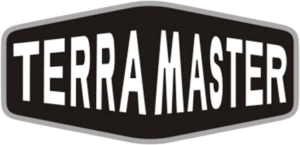
THE NEW TERRAMASTER OPERATING SYSTEM 5.0 is still a work in progress. And it isn’t, as we first thought, strictly speaking, a beta test version. For a beta test, participating users would be invited to submit bugs, typically into a system that lists the bugs known to date and classifies them as Open (still being investigated) or Closed (fixed and ready for the next update).
Properly submitting a bug isn’t just a matter of whining about it in a forum. It can take considerable time for the submitter to check that the bug isn’t just user error, to define what the failing function is expected to achieve as against what it actually does, and to provide establishing details and screenshots.
 TerraMaster isn’t offering a formal bug submission system, which means that any user of the 5.0 beta version who discovers a bug won’t know if it’s worth the trouble of submitting. TerraMaster is calling this current version of TOS 5.0 an “Insider Preview”. It’s possible to submit bug reports to the TerraMaster forum or by email to TerraMaster’s marketing department. But “Insider Preview” seems rather to suggest that users are simply spectators of this work in progress, with bug reports not being particularly encouraged.
TerraMaster isn’t offering a formal bug submission system, which means that any user of the 5.0 beta version who discovers a bug won’t know if it’s worth the trouble of submitting. TerraMaster is calling this current version of TOS 5.0 an “Insider Preview”. It’s possible to submit bug reports to the TerraMaster forum or by email to TerraMaster’s marketing department. But “Insider Preview” seems rather to suggest that users are simply spectators of this work in progress, with bug reports not being particularly encouraged.
So in this first instalment we’ll focus on the hardware and hope that TerraMaster’s developers will discover the bugs we’ve been coming across and that software fixes will arrive in time for our follow-up. At the time of writing there have already been six updates (we’re now at version 5.0.67) and the improvements have been very encouraging.
For this review, Seagate has very kindly donated a pair of its new 20TB Exos drives. These are a step up from the 18TB drives Seagate provided for our UnRAID review last year.
But these drives are only a small step for Seagate toward even larger capacities in the near future, with 50TB drives expected in four years time. More on the Exos drives below and more to follow in part 2.
TerraMaster’s Solid Proposition
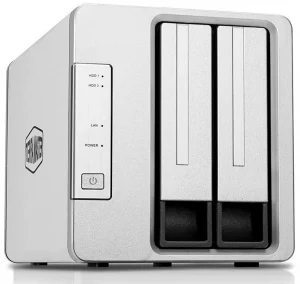
The most immediately obvious feature of the F2-210 (like the F2-221) is its build quality. This is clearly not some disposable plastic lightweight. The case is a chunk of one-piece solid aluminium with a workhorse 80mm rear fan, reassuring you this thing is going to stay cool.
The picture shows the F2-210 but the F2-221 looks exactly the same. Juggling these numerical names is going to be confusing as we proceed through this review, Here at Tested Technology Towers we’ve taken to calling them ARMie and TELlie, so it might be helpful to proceed on this basis here.
TerraMaster takes a very different approach. Their entry-level F2-210 offers twice the processor cores, twice the memory and uses real hot-swap drive bays for a pair of drives that can be mirrored (for resiliance) or volumed together (for capacity).
Power Consumption

The Armie is built around a four-core 1.4GHz ARM Realtek RDT1296. It runs at around 12W. The Intel-based Tellie uses an Apollo J3355, clocked at 2.0GHz. As you’d expect, it sips more juice at around 17W, although this processor is only dual-core.

*Youngsters will be baffled by this 1950s reference, so here’s a visual clue.
You might think this additional power consumption is because the Tellie is loaded with a pair of Seagate 20TB drives kicking sand* in the face of the Armie with its much skinner 4TB drives. Not so.
The data capacity increase of drives has actually brought a significant drop in power consumption per gigabyte.
Consumer NASes will see a benefit, obviously, but it’s the guys running the data centres who are really cheering this on. Yes, a 20TB drive takes more juice than a 10TB drive (5.4W as opposed to 4.5W per drive). But replacing an array of 48 10TB drives with 24 20TB drives is going to save a lot on the electric bill.
(Not that this is what’s happening in data centres. They’re racing to increase their capacity, so that array of 48 old 10TB drives will be replaced by 48 new 20TB drives. It’s just that the electricity bill won’t be climbing linearly with capacity.)
So a fraction of the difference in power consumption between the Armie and the Tellie will be down to the drives. But the main juice burner in each device is the processor.
The Drive Bays
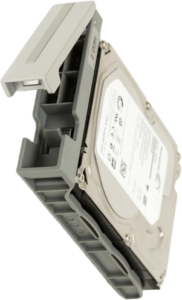 The drive caddies are plastic, flexible without feeling flimsy. Once the drives are screwed into place** each caddy becomes a hefty, solid unit that slides easily into its bay.
The drive caddies are plastic, flexible without feeling flimsy. Once the drives are screwed into place** each caddy becomes a hefty, solid unit that slides easily into its bay.
Don’t be tempted to push on the front lever until the caddy is snugly housed, with its power and data connectors engaged at the rear. Pressing the front lever home at this stage inches the caddy into its final position, latching against a catch at the top of the bay. An easy mistake to make is to start closing the front lever too early. Exerting force before the drive’s rear electronic connectors begin to engage risks breaking the latch at the top of the lever.
Many pro and semi-pro NAS devices use bays that are lockable with a key once they are fully latched. As protection for expensive drives against sneak theft this might strike you as a useful feature which is missing from these TerraMaster machines. In fact all the lockable NAS devices we’ve come across here at Tested Technology use the identical industry standard key. Any self-respecting sneak thief will be going about their business with this key ready to hand. The best way to protect your drives against theft is to lock the whole NAS device in a cupboard (with sufficient ventilation).
Which brings us to…
The Seagate Drives
Well, we’re immensely impressed. Maybe you’re not, but maybe you haven’t been around IT for as long as we have.
The first hard drive we encountered, the Seagate ST-506—that we manually installed in a Vector Graphic Z System B CP/M machine—added all of 5MB to the machine’s dual-floppy storage. That’s megabytes. “Mega” means “big”, and back in 1981 5MB was indeed very big.
Twenty years later, at the turn of the century, Seagate shipped its 250 millionth hard drive. This was the somewhat whiny but speedy Cheetah X15 with a capacity of 18 gigabytes. That’s 3,600 of those old ST-506es in a form-factor half the height.
And here we are now in 2022 with a single drive, the Exos 20, whose 20 terabyte capacity easily exceeds a thousand of those turn-of-the-century Cheetahs.
Or—and this is what sets my own head spinning—four million times that 1981 CP/M machine’s ST-506 drive.
Stay Cool
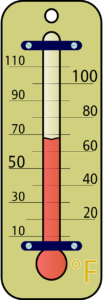
The Seagate drives are rated to run at temperatures between 5°C–60°C. That’s a very reasonable tolerance—the upper figure has increased by about 5°C over the past decade. But your hard drive will still be the most temperature-sensitive device among all the components in a hardware system.
So the lower the temperature of your drive, the better?
No, don’t get this wrong. As long as your drive stays within the range limits it should be fine. It just happens that the range limits of hard drives—with their combination of electronics and precision mechanics—are narrower than most other components. A typical central processing unit, for example, will boil water before it shuts down.
And speaking of shutting down, or the half-way measure towards that, thermal throttling (reducing the performance to lower the waste energy generated), how does a hard drive respond to overheating?
Seagate’s engineering department gave us the low-down on this. The reliability metrics (measured as MTBF, or mean time between failures) are based on a temperature of 30°C, in the middle of the operational range. Short fluctuations above or below this that don’t exceed the operational range should have no adverse effect on reliability.
Running at extreme temperatures for extended periods may well shorten the life of the drive.This will also degrade immediate performance because the drive will start adding extra steps to the read/write process to maintain data integrity. This slowdown will appear to have much the same characteristics as the thermal throttling of a processor. But in this case the drive isn’t reducing power consumption to lower the temperature—if anything, the additional work involved will be increasing the power consumption and possibly even raising the temperature.
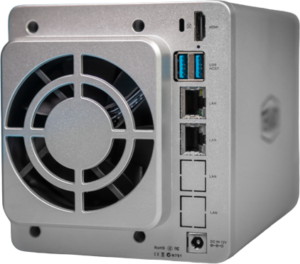 Seagate tells us the drives are designed to shut down if they get too hot. But in any normal use case, the electronics of the drive enclosure will have kicked in before then to perform its own thermal shutdown.
Seagate tells us the drives are designed to shut down if they get too hot. But in any normal use case, the electronics of the drive enclosure will have kicked in before then to perform its own thermal shutdown.
The Armie and the Tellie are each equipped with a large 80mm fan that protrudes from the rear like a warehouse external air conditioning unit. The TOS firmware can set the fan to run Slow, Medium or Fast, but you’re more likely to settle on the additional Smart option that correlates the fan speed to the temperature.
It’s from the rear that you can tell these two machines apart. The picture here shows the Tellie, the F2-221. Like the Armie, it has a pair of USB3 sockets and a pair of gigabit Ethernet sockets to the right of the fan housing. The difference is that socket in the top right hand corner. HDMI output is mentioned nowhere in the manuals we’ve been able to get our hands on.
But it works!
The Price is Wrong
That’s our feeling here at Tested Technology about these two TerraMaster two-bay drives—fuelled by the fact that when we were first introduced to the F2-210 by TerraMaster’s donation, you could pick this device up for rather less than the single-drive Synology DS-120j we had just finished reviewing.
Current Amazon UK pricing puts the TerraMaster F2-210 at around £150—£50 more than Synology’s entry-level offering. But that’s a single-bay NAS. A fairer comparison might be with Synology’s cheapest two-bay NAS, the DS220j for £170. This uses the same processor as the TerraMaster F2-210 but only has half the memory (512MB) and its plastic case has no easily swappable drive bay/caddy arrangement.
On the basis of hardware and build quality, the TerraMaster F2-210 wins easily. But, as we’ve said, Synology’s DSM operating system is currently well ahead of Terramaster’s TOS. Should you pay £20 more for the Synology? It’s a dilemma—balancing on the question of TerraMaster’s new TOS 5.0 operating system.
Recent months have been a strange time for IT pricing. Processors are in short supply and international shipping costs have gone through the roof.
TerraMaster’s F2-210 could be cheaper. And has been. And, we’re fairly confident, will be again. Even so, at around £150 for a very solidly build dual-bay NAS it is still looking competitive. The deciding factor will be how the TerraMaster operating system version 5 pans out.
Which is what we hope to be talking about in Part 2.
Chris Bidmead 12-Apr-22
